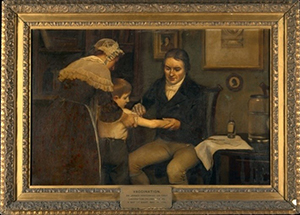Introduction

Smallpox
Take a look at the two photos below. What do they have in common?


Image 1 (left) and Image 2 (right)
Smallpox is one of greatest scourges plagues in human history. The disease has been around since 10,000 BCE Before Common Era , and it has killed an estimated 300 million people in the 20th century alone.
Smallpox starts with a distinctive rash that progresses to pus-filled blisters and can result in disfiguration, blindness, and death. It was eradicated by 1972 through the World Health Organization vaccination program. Today, about 50 percent of the population has never been vaccinated because the smallpox vaccination is not a regular part of childhood vaccines in America.
It was eradicated by 1972 through the World Health Organization vaccination program. Today, about 50 percent of the population has never been vaccinated because the smallpox vaccination is not a regular part of childhood vaccines in America. If you are interested in learning more about the eradication of this disease, go to "Smallpox: Eradicating the Scourge” and read about it.

Vaccines
Let's explore these images again.


Image 1 (left) and Image 2 (right)
Image 2 (right) shows 18th century English doctor, Edward Jenner inoculating a boy with cow pox viral skin infection caused by the cowpox virus to induce immunity to the viral disease, smallpox. Jenner is attributed as the “father of vaccination” as he created the first vaccine for smallpox. A vaccine is any preparation used as a preventive inoculation to confer immunity against a specific disease, usually employing a killed or weakened bacteria or viruses, to stimulate antibody production.
Image 1 (left) shows a man lying in bed. He has the smallpox disease, and he was never vaccinated.
Today, vaccines are a common way to provide an active immunity to a disease without having the disease and all its symptoms. To see how a virus attack on the body occurs and how the immune system responds with antibodies, watch the video Immune Cells in Action (1:40) below.
Open Immune Cells in Action in a new tab
Now, let’s learn all about the immune system structures, functions, and diseases.
| Lesson Objectives |
Following successful completion of this lesson, students will be able to...
Enduring Understandings
The above objectives correspond with the Alabama Course of Study: Anatomy and Physiology standards: 12 and 12a |
